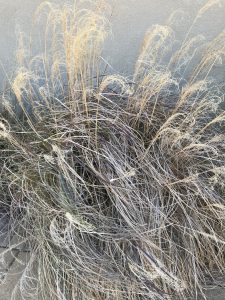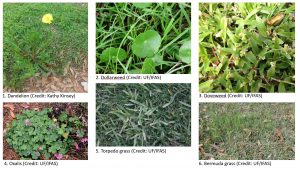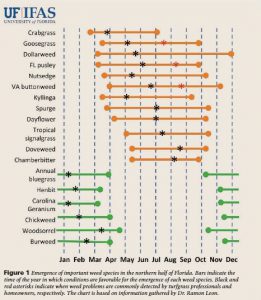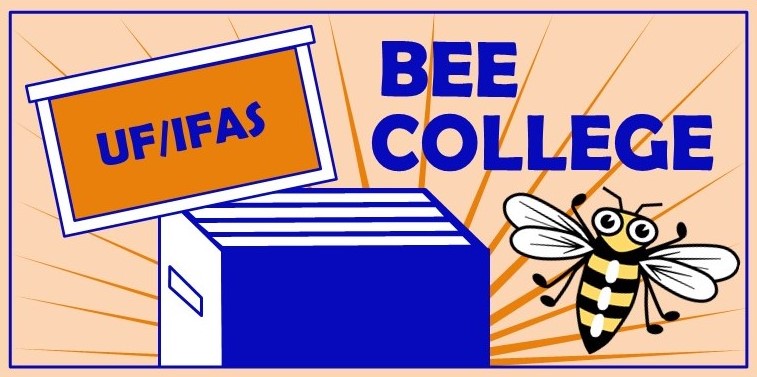

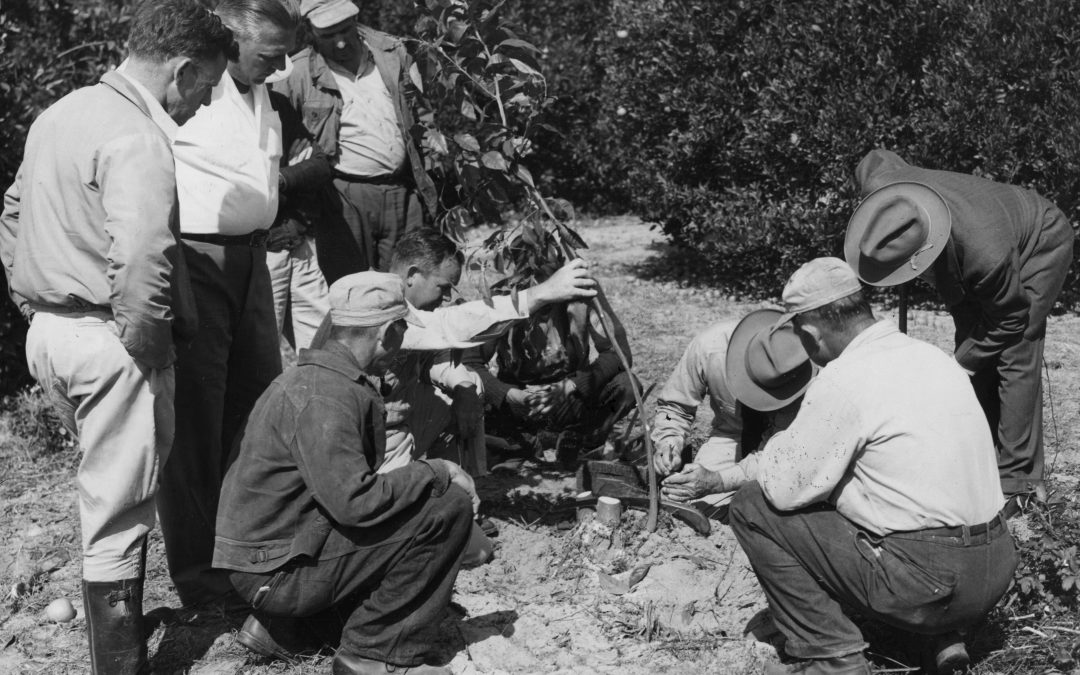
Fruit Tree Grafting Tips and Scion Selection
It’s mid-February, cloudy, and cold. It’s time to get outside and take cuttings for fruit and nut tree grafting. The cuttings that are grafted onto other trees are called scions. The trees or saplings that the scions are grafted to are called rootstocks. Grafting should be done when plants start to show signs of new growth, but for best results, scion wood should be cut in February and early March.
Scion Selection
Straight and smooth wood with the diameter of a pencil should be selected for scions. Water sprouts that grow upright in the center of trees work well for scion wood. Scions should be cut to 12-18″ for storage. They should only need two to three buds each.
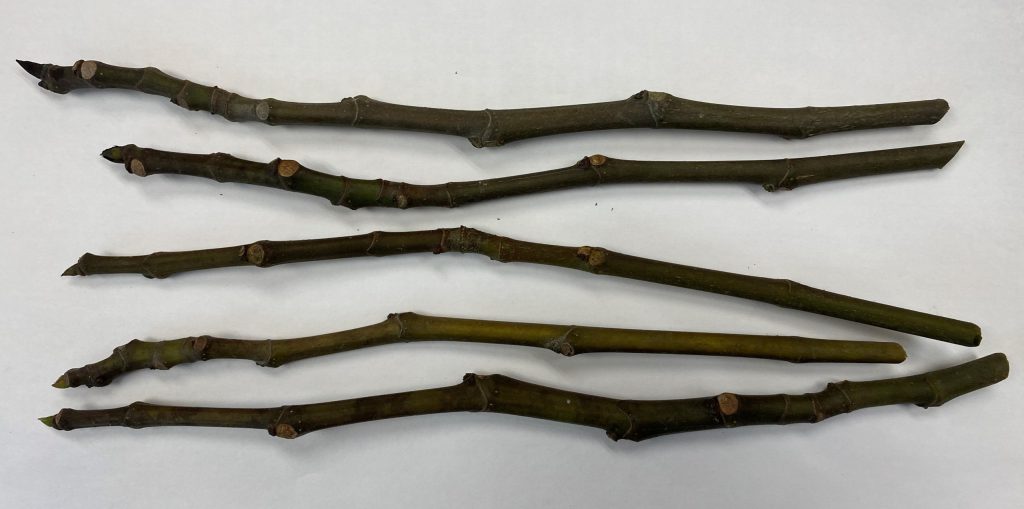
Scions ready for grafting. Photo Credit: Matt Lollar, University of Florida/IFAS Extension – Santa Rosa County
Scion Storage
Scions should be cut during the dormant season and refrigerated at 35-40°F until the time of grafting. If cuttings are taken in the field or far from home, then simply place them in a cooler with an ice pack until they can be refrigerated. Cuttings should be placed in a produce or zip top bag along with some damp paper towels or sphagnum moss.
Grafting
It is better to be late than early when it comes to grafting. Some years it’s still cold on Easter Sunday. Generally, mid-March to early April is a good time to graft in North Florida. Whip and tongue or bench grafting are most commonly used for fruit and nut trees. This type of graft is accomplished by cutting a diagonal cut across both the scion and the rootstock, followed by a vertical cut parallel to the grain of the wood. For more information on this type of graft please visit the Grafting Fruit Trees in the Home Orchard from the University of New Hampshire Extension.
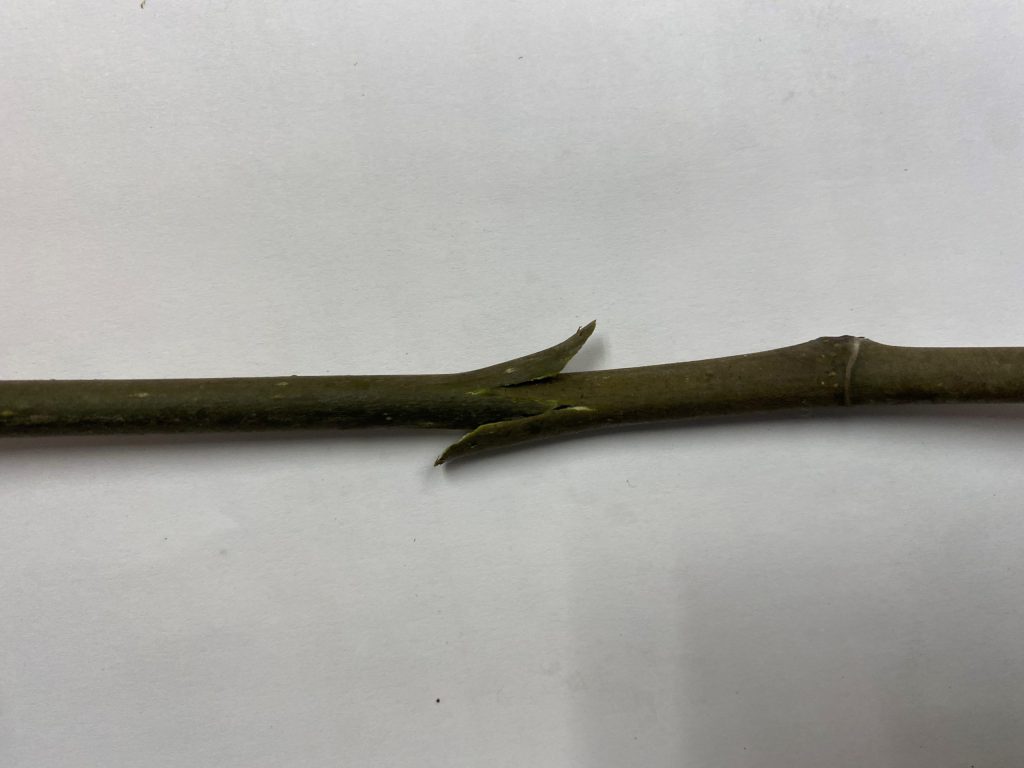
A bench graft union. Photo Credit: Matt Lollar, University of Florida/IFAS Extension – Santa Rosa County
Achieving good bench graft unions takes skill and some practice. Some people have better success using a four-flap or banana graft technique. This type of graft is accomplished by stripping most of the bark and cambium layer from a 1.5″ section of the base of the scion and by folding the back and removing a 1.5″ section of wood from the top of the rootstock. A guide to this type of graft can be found on the Texas A&M factsheet “The Four-Flap Graft”.
Grafting is a gardening skill that can add a lot of diversity to a garden. With a little practice, patience, and knowledge any gardener can have success with grafting.
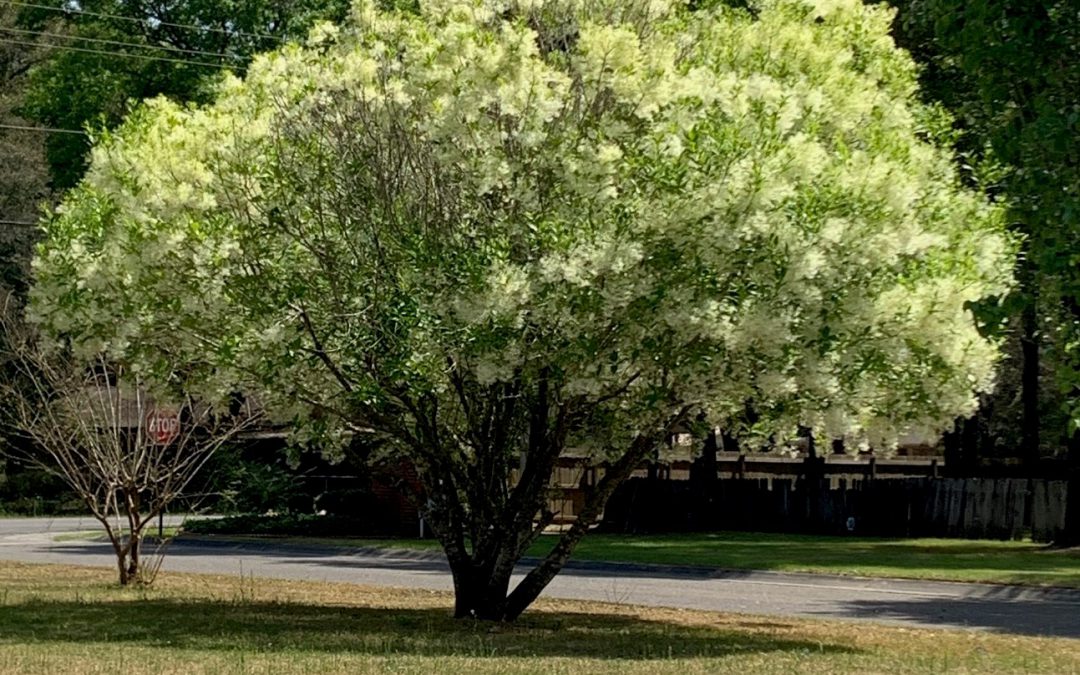
Choosing a Tree for Your Landscape
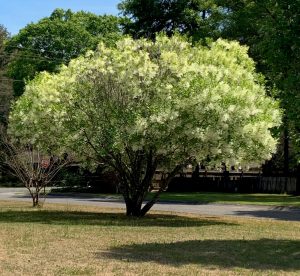
American fringetree Chionanthus virginicus), a native deciduous small tree with delicate blooms in spring. Photo credit: Mary Salinas, UF/IFAS Extension.
January and February are ideal months for adding a tree or two to your landscape in the Florida panhandle. In the cooler weather, the ground stays moist for a longer time, which helps prevent drought stress and the drying out of the rootball. Also, the winds are generally milder, and the tree will have a chance to get established and anchored in before the wilder winds of summer roll in.
Before investing time and money in a tree, take a few minutes and be sure that the species you choose is right for your particular landscape.
Here are some things to consider:
- Whether the area can accommodate the ultimate size of the tree, both height and width, and not grow into overhead wires, streetlights, or your house.
- Are there any underground utilities or septic? A call to 811 can check on where your utilities are.
- The hardiness zone for the tree. Be aware that zone 8 or 9 in the western United States is a different climate with respect to moisture than the same zone 8 or 9 in Florida.
- Whether the tree can thrive in your soil – sandy, loam or clay, loose or compacted, high and dry, or wet and low.
- The amount of sun it requires.
- Whether you want native species that provide food and habitat for native birds and animals.
- Salt-tolerance if located on the coast.
- Wind tolerance, especially if located on the coast. Many fast-growing trees are brittle and susceptible to breakage.
- Whether you prefer an evergreen or deciduous tree. Evergreen trees, like hollies, provide a natural screen all year while some deciduous trees, like maple and bald cypress, provide fall color.
- Is the tree messy, dropping large seed pods, fruit, or leaves?
- The color and shape of leaves and flowers and other ornamental qualities.
- Whether the tree species has known disease or pest issues.
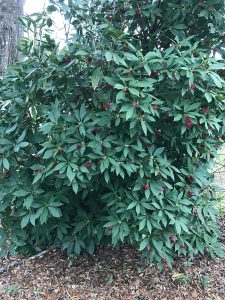
Florida red anise (Illicium floridanum), a small tree/large shrub for shady locations. Photo credit: Mary Salinas UF/IFAS Extension.
Once you choose what species of tree you will add to your landscape, here’s information on Selecting Quality Trees from the Nursery.
Optimum tree health and vigor also depends on the correct methods of Planting and Establishing Trees.
And this site has even more comprehensive information on trees and shrubs: University of Florida/IFAS Landscape Plants.
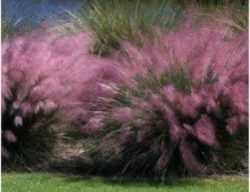
Ornamental Grass Pruning – A Winter Task
The term “ornamental grass” is a catch-all phrase used to describe grasses and “grass-like” plants. Individual species are adapted to a wide variety of landscape sites (i.e., wet or dry, sun or shade, hot or cold climates, and varied salt tolerance). Growth habits range from low ground covers to intermediate shrub-like plants to very tall hedge-like plants. Ornamental grasses are very dynamic; the size, shape, texture, and color of grass changes with every season.
Grasses with foliage that dies in the winter and remains dormant until the weather warms in the spring are considered deciduous. The winter character of deciduous ornamental grasses adds tremendous interest to the winter garden when contrasted with evergreen plants or structures such as walls or fences. The dried foliage of deciduous grasses creates sound as it expands and contracts in response to changes in temperature or moisture, while interaction with wind creates movement in the garden. For these reasons, pruning of the dead foliage and inflorescences is not recommended at the time of the first frost.
Pruning of ornamental grasses should be done in late winter or early spring, just prior to new shoot growth. In Northwest Florida, gardeners should target the end of February to prune ornamental grasses. For deciduous grasses, such as Japanese silver grass (Miscanthus sinensis), the old foliage may be completely removed within inches of the soil. Be cautious to not remove the growth point by leaving the grass clump at least 4 inches high. For evergreen grasses, such as muhly grass (Muhlenbergia capillaris), the ragged leaves can be removed to neaten the appearance of the plant without shortening all the way to the ground. So, depending on the damaged portions, the remaining grass clump can be 6-18 inches high after pruning. Grasses recover quickly from a heavier pruning. Within a few months the plant will have completely regrown. If desired, old flower stalks and seed heads may be removed any time they no longer have a neat appearance. For more information on ornamental grass species and growing tips, please visit the EDIS Publication: Considerations for Selection and Use of Ornamental Grasses.
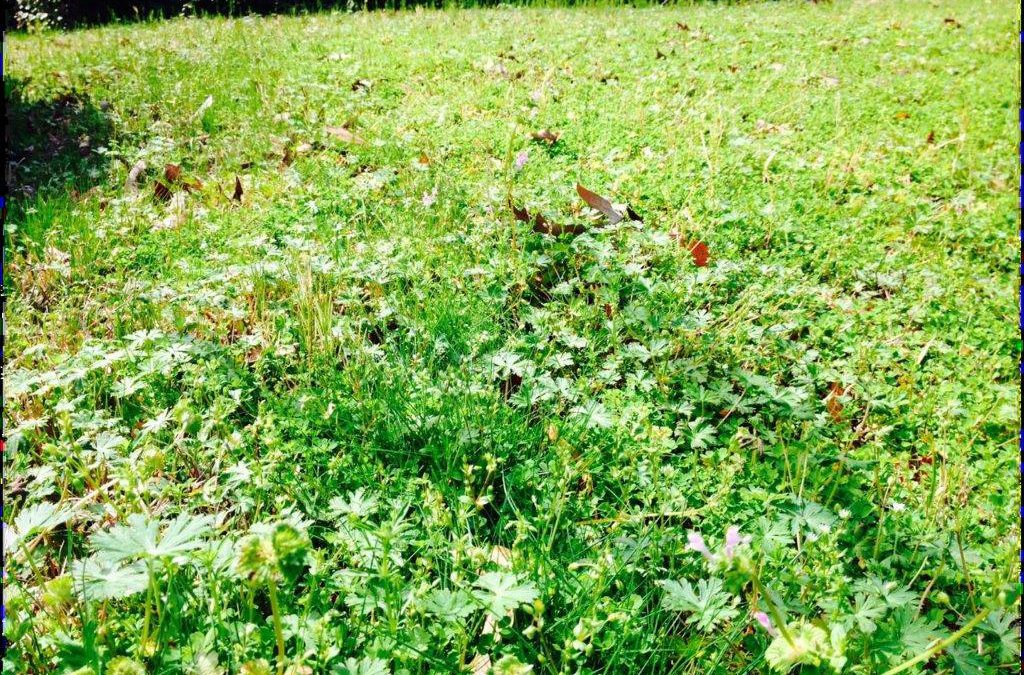
Gardening in the Panhandle LIVE Program Summary: Weeds – February 4, 2021
Gardeners worldwide and throughout time have bemoaned weeds. In Florida, we get to enjoy weeds all year long! Our February Gardening in the Panhandle (GIP) Live episode focused on weeds and weed control. Many homeowners are interested in ways to control weeds and UF/IFAS Extension and your local extension agents are here to help. The following is a summary of the topics we discussed and links for more research-based information on weeds.
What is a Weed?
Many folks come to the extension office holding a plant and ask, “Is this a weed”? Well, whether it is a weed or not is up to the individual, as the only definition for a weed is “a plant out of place”. Bermudagrass and Oxalis are good examples of plants that some try to grow while others try to kill. One person’s weed is another’s wildflower! However, to be clear, plants classified as invasive by UF/IFAS and governmental entities are officially weeds. There are resources to help identify several common plants that are generally considered weeds by most homeowners and landscapers.
Weed ID Links
- Florida Weeds: https://sfyl.ifas.ufl.edu/lawn-and-garden/florida-weeds/
- Edible Weeds: https://content.ces.ncsu.edu/extension-gardener-handbook/6-weeds
- Identifying Weeds: Virginia Tech: https://weedid.cals.vt.edu/ and NC State: https://www.turffiles.ncsu.edu/weeds-in-turf/
- Weeds of Southern Turfgrass: http://ifasbooks.ifas.ufl.edu/p-150-weeds-of-southern-turfgrasses.aspx
How to Prevent Weeds?
There are some general gardening practices that can help prevent weeds so there is less of a need to control them. A lawn that is healthy is less likely to be invaded by weeds and the use of mulch can greatly reduce weed growth in planting beds. Other practices, like the placement of weed fabrics/cloths are less effective and/or less practical in many garden situations.
Weed Prevention Links
- Mulching Guidelines: https://ag.umass.edu/home-lawn-garden/fact-sheets/mulching-weed-management-in-urban-landscape
- FYN Handbook – Principle #s 1, 2, 3, 4, 6: https://ffl.ifas.ufl.edu/materials/FYN_Handbook_2015_web.pdf
- Consider Landscape Fabric Carefully: http://blogs.ifas.ufl.edu/escambiaco/2016/08/12/consider-landscape-fabric-carefully-2/
How to Control Weeds?
Once you know and/or decide that what you have is a weed and that it needs to be dealt with, then you have to consider your control options. Prevention, as mentioned above, is key but sometimes you may need to use other methods of control, such as physical, mechanical, and/or chemical means. With chemical weed control, it is important to always read and follow the product label.
Weed Control Links
- Weed Management Guide for Florida Lawns: https://edis.ifas.ufl.edu/ep141
- Weed Control in Planting Beds: https://edis.ifas.ufl.edu/ep523
- Non-Chemical Weed Control: https://edis.ifas.ufl.edu/hs1170
- Summer Annual Weed Control Timeline: https://sfyl.ifas.ufl.edu/media/sfylifasufledu/escambia/horticulture/Summer-Annual-Lawn-Weed-Control-Timeline.pdf
- Winter Annual Weed Control Timeline: https://sfyl.ifas.ufl.edu/media/sfylifasufledu/escambia/horticulture/Winter-Annual-Lawn-Weed-Control-Timeline.pdf
- Florida Homeowner Herbicide Guide: https://edis.ifas.ufl.edu/pdffiles/EP/EP57500.pdf
- National Pesticide Information Center: http://npic.orst.edu/
- Glyphosate Alternatives: https://edis.ifas.ufl.edu/ep580
- Pesticide Use Around Pets: http://npic.orst.edu/health/pets.html
Specific Weed Recommendations
When managing pests, proper identification is key to effective control. Because some weeds are annuals, and present either during the cool or warm season, and others are perennials, proper weed identification can provide a more detailed control strategy. Use the weed ID links above and the document links below for more precise, and effective, weed management.
Species-Specific Control Links
- Dandelion Control: http://ipm.ucanr.edu/PMG/PESTNOTES/pn7469.html
- Dollarweed Biology and Management: http://edis.ifas.ufl.edu/ep389
- Doveweed Control: https://edis.ifas.ufl.edu/pdffiles/AG/AG39500.pdf
- Johnsongrass ID and Control: https://edis.ifas.ufl.edu/ag372
- Oxalis Control: https://edis.ifas.ufl.edu/ep514
- Torpedograss Control: https://plants.ifas.ufl.edu/plant-directory/panicum-repens/
If you need additional assistance with weed control, please contact your local county extension office. Please tune in for future GIP LIVE episodes for more research-based information on gardening topics.

